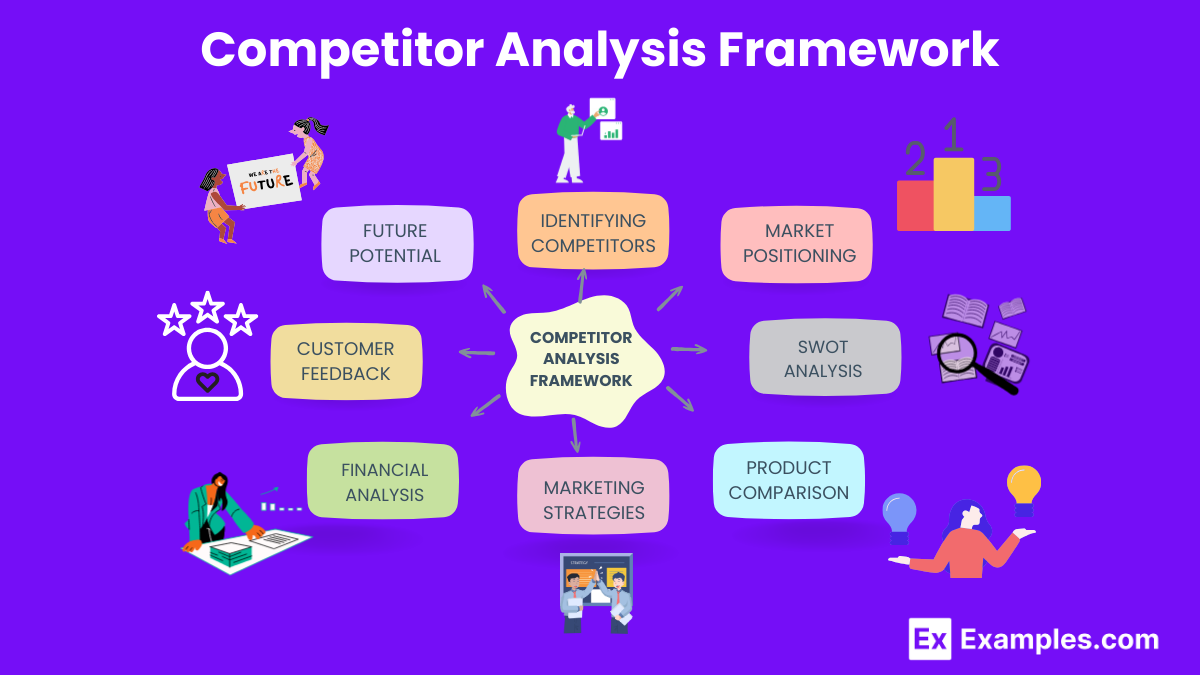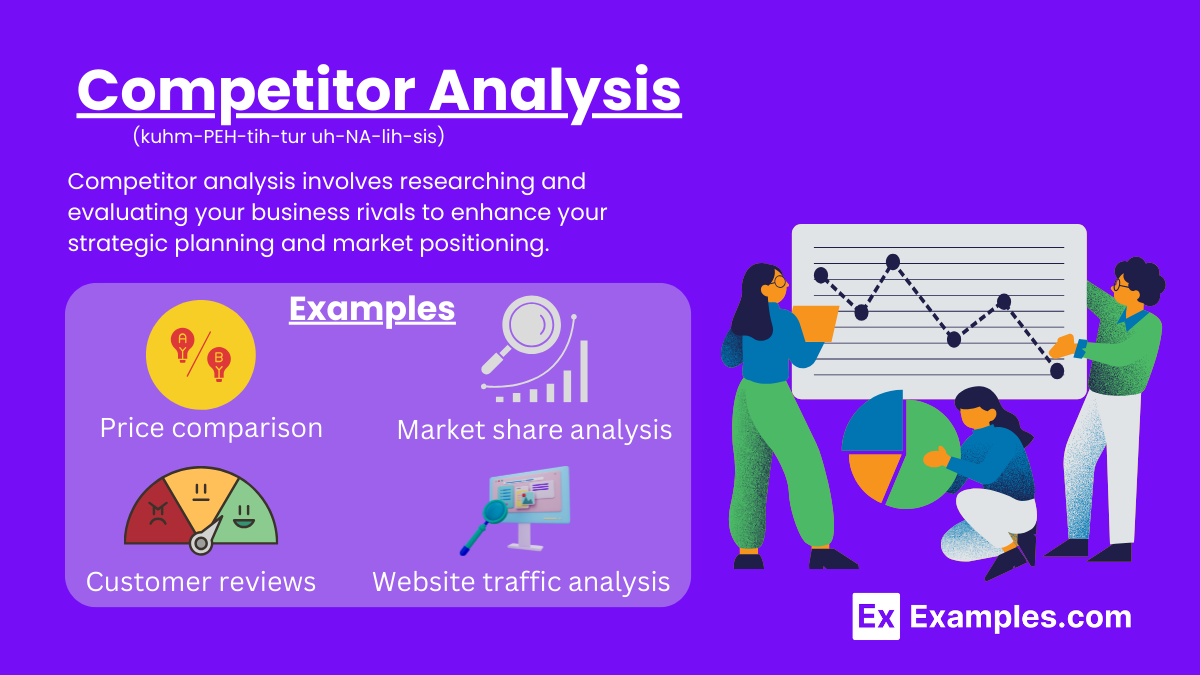Competitor Analysis – Examples, Types, Tools, Research, Benefits
Competitor analysis is a critical process for businesses to understand their market position and strategic advantages. By conducting a competitor SWOT analysis, companies can identify their strengths, weaknesses, opportunities, and threats compared to their rivals. This analysis helps in developing effective strategies, improving market positioning, and anticipating market trends. Understanding competitors’ tactics and performance provides valuable insights that drive informed decision-making and foster competitive growth.
What is Competitor Analysis
Competitor analysis is the strategic process of evaluating the strengths, weaknesses, opportunities, and threats of current and potential competitors. This analysis helps businesses understand market dynamics, improve strategies, and identify areas for growth and differentiation.
Competitor Analysis Examples
- Price comparison – Analyzing competitors’ pricing strategies to adjust your own.
- Product features comparison – Evaluating competitors’ product features to enhance your offerings.
- Market share analysis – Assessing competitors’ market share to identify your market position.
- Marketing strategies review – Studying competitors’ marketing tactics to refine your own campaigns.
- Customer reviews – Analyzing competitor feedback to improve your product or service.
- Website traffic analysis – Comparing website traffic data to optimize online presence.
- SWOT analysis – Evaluating competitors’ strengths, weaknesses, opportunities, and threats.
- Social media monitoring – Tracking competitors’ social media activity to enhance engagement.
Types of Competitor Analysis
Direct Competitor Analysis : This analysis focuses on businesses that offer the same products or services to the same target market. By examining their strengths, weaknesses, and market strategies, you can identify opportunities to differentiate your offerings and improve your competitive position.
Indirect Competitor Analysis : Indirect competitors provide alternative solutions that meet the same customer needs. Analyzing these competitors helps you understand potential threats from different market segments and adapt your strategies accordingly.
Future Competitor Analysis : This involves identifying potential new entrants into your market. Understanding their capabilities, market potential, and possible strategies allows you to anticipate and prepare for future competition.
Competitive Market Analysis : Competitive market analysis examines the broader competitive landscape, including direct, indirect, and future competitors. This comprehensive approach helps you understand market dynamics, identify trends, and develop effective strategies to enhance your market position.
Industry Market Analysis : Industry market analysis focuses on the overall industry environment, including key players, market size, growth potential, and regulatory factors. This analysis helps you identify industry trends and opportunities, enabling you to make informed business decisions.
Competitor Analysis Tools
SWOT Analysis: Evaluates strengths, weaknesses, opportunities, and threats for strategic planning and decision-making.
Porter’s Five Forces: Assesses industry competitiveness through five key forces to determine market attractiveness and profitability using target market analysis.
Benchmarking: Compares company performance against industry leaders to identify best practices and areas for improvement.
PEST Analysis: Analyzes political, economic, social, and technological factors influencing market dynamics and strategic planning.
Competitive Profile Matrix (CPM): Rates competitors based on key success factors to visualize competitive landscape.
Market Segmentation: Divides market into segments to identify and target specific customer groups effectively through market analysis for business.
Perceptual Mapping: Visualizes product positioning based on customer perceptions to identify market gaps and opportunities.
Customer Feedback Analysis: Gathers and analyzes customer feedback to understand market needs and improve product offerings.
Social Media Monitoring: Tracks competitors’ social media activities to gain insights into their strategies and customer engagement through a data analysis report.
Financial Ratio Analysis: Compares financial metrics to assess competitors’ financial health and performance.
Competitor Analysis in Marketing
Competitor analysis in marketing is a crucial aspect of developing a comprehensive business analysis report. This process involves examining direct and indirect competitors to understand their strengths, weaknesses, strategies, and market positions. By leveraging tools such as SWOT analysis, Porter’s Five Forces, and benchmarking, businesses can gather valuable insights into the competitive landscape. This analysis helps identify market opportunities, anticipate threats, and develop strategies to improve market positioning. Incorporating competitor analysis into a business analysis report ensures a well-rounded understanding of the market, enabling informed decision-making and strategic planning.
Competitor Analysis Framework

- Identifying Competitors: Recognize direct, indirect, and potential competitors to understand the competitive landscape.
- Market Positioning: Evaluate competitors’ market positions to identify strengths, weaknesses, and market gaps.
- SWOT Analysis: Analyze competitors’ strengths, weaknesses, opportunities, and threats for strategic insights.
- Product Comparison: Compare competitors’ products and services based on features, quality, and pricing.
- Marketing Strategies: Assess competitors’ marketing strategies, including advertising, promotions, and customer engagement.
- Financial Analysis: Review competitors’ financial health through revenue, profit margins, and market share.
- Customer Feedback: Gather and analyze customer feedback on competitors to understand market perception and satisfaction.
- Future Potential: Evaluate potential future threats from emerging competitors or industry trends.
Competitor Analysis UX
Competitor analysis in UX (User Experience) involves evaluating how competitors design and implement their user interfaces to attract and retain customers. This analysis includes conducting a company Swot analysis to identify the strengths, weaknesses, opportunities, and threats related to user experience. By examining competitors’ website and app designs, navigation ease, and overall user satisfaction, businesses can gain valuable insights into what works well and what areas need improvement. This detailed competitor analysis in UX helps companies refine their own user interfaces, enhance customer satisfaction, and stay ahead in the market by leveraging the findings from the company SWOT analysis.
Competitor Research
Step 1: Identify Competitors: Recognize direct, indirect, and potential competitors to understand the competitive landscape comprehensively.
Step 2: Gather Data: Collect information on competitors’ products, services, marketing strategies, and customer feedback.
Step 3: Analyze Strengths and Weaknesses: Conduct SWOT analysis to determine competitors’ strengths, weaknesses, opportunities, and threats.
Step 4: Evaluate Market Position: Assess competitors’ market positions to identify gaps and opportunities for your business.
Step 5: Monitor Competitor Activities: Continuously track competitors’ actions and strategies to stay updated and adjust your approach accordingly.
How to Use Competitor Analysis
- Identify Competitors: Recognize direct, indirect, and potential competitors.
- Gather Data: Collect information on competitors’ products, services, and strategies.
- Conduct SWOT Analysis: Evaluate strengths, weaknesses, opportunities, and threats.
- Compare and Evaluate: Assess your position relative to competitors.
- Develop Strategic Actions: Use competitive analysis insights to refine your business strategy.
How to Make Competitor Analysis Report:
- Identify Competitors: Research and list direct and indirect competitors in your industry.
- Gather Data: Collect information on competitors’ products, pricing, marketing strategies, strengths, and weaknesses.
- Analyze Strengths and Weaknesses: Evaluate each competitor’s strengths and weaknesses compared to your business.
- Compare Market Position: Assess your competitors’ market share, customer base, and overall market positioning through thorough competitive analysis.
- Develop Strategies: Use the analysis to identify opportunities, threats, and strategies to improve your competitive advantage.
Benefits of Conducting Competitor Analysis
- Identify Market Opportunities: Discover gaps in the market that your business can exploit.
- Understand Competitors’ Strategies: Gain insights into competitors’ marketing, pricing, and product strategies.
- Improve Business Strategies: Refine your business approach by learning from competitors’ successes and failures.
- Enhance Product Development: Develop better products by understanding competitors’ strengths and weaknesses.
- Increase Market Share: Implement strategies that can help you capture a larger portion of the market.
- Anticipate Market Trends: Stay ahead of industry trends by observing competitors’ adaptations.
- Improve Customer Satisfaction: Learn from competitors’ customer feedback to enhance your offerings.
- Boost Competitive Advantage: Strengthen your market position by leveraging insights gained from competitor analysis.
Why is competitor analysis important?
It helps businesses identify market opportunities and threats.
What are the key components of competitor analysis?
Market position, product offerings, pricing strategies, and marketing tactics.
How often should a business conduct competitor analysis?
At least once a year, but more frequently in rapidly changing markets.
What tools are commonly used for competitor analysis?
Tools like SEMrush, Ahrefs, and SimilarWeb are commonly used.
What is the first step in conducting a competitor analysis?
Identifying your main competitors.
How can competitor analysis benefit marketing strategies?
It helps refine marketing tactics to better compete in the market.
What data is crucial in competitor analysis?
Sales data, market share, customer reviews, and product features.
How does competitor analysis impact product development?
It highlights gaps and opportunities for innovation.
What is a competitive advantage?
A unique strength that sets a business apart from its competitors.
How can a business use competitor analysis in pricing strategy?
By understanding competitors’ pricing, a business can adjust its prices competitively.


